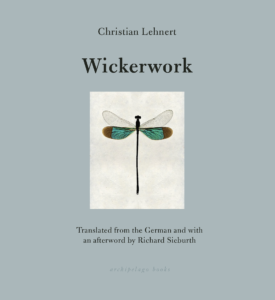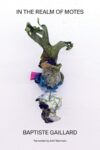
[Archipelago Books; 2025]
Tr. from the German by Richard Sieburth
A popular legend holds that, on his rambles through the countryside of his native Thuringia, Johann Wolfgang von Goethe often filled his pockets with seeds that he would scatter as he went. Like all uncorroborated stories about the habits of poets, the image of a pensive Goethe sowing cinquefoil or hawthorn unites simple biography with the force of myth. The poet’s affinity for the natural landscape that formed him was so strong that a network of footpaths leading from the center of Weimar, his birthplace, to the municipality of Großkochberg would eventually be christened Goetheweg (Goethe Way). There is nothing fabular about imagining the author of Versuch die Metamorphose der Pflanzen (The Metamorphosis of Plants) seeding the earth on which he walked. In a text written in 1819, some two decades after the publication of this work, Goethe made the following note about plant metamorphosis:
The seed already contains the organs which will divide the plant into two parts: those with a decided tendency to grow into the earth, seeking moisture and darkness, and those with a need to grow up into the light and air…
So too the poet, whose fertile mind produced a body of work in which the alternating search for darkness and light is recorded with striking intensity. Goethe the plant morphologist and naturalist was destined to dim in comparison with the poet. A mutual bond remains, however, between the poet and the natural phenomena that animated his literary and scientific works, from the Goetheweg wending through the Thuringian hills to the famous oak near Weimar where he was said to have composed the Walpurgisnacht (Walpurgis Night)passages of his Faust.
Nature crafts its own metaphors. The rehearsal and re-rehearsal of the narrative of this tree, felled during the clearing of the surrounding forest to make way for the construction of Buchenwald, is another in a long series of footnotes reinforcing the peculiar Goethe-mythos. Like the seed containing both embryonic root and stem, the oak, now reduced to its stump, is a narrative stretching downward into the soil of history and up to the present, where the tree finds its place among the unnatural artifacts of a museum of atrocities. But the investment of memorial significance in the oak-stump, often pictured covered with stones like a grave, removes from this charged object its most essential aspect, the quality which moved Goethe to write in a letter to Charlotte von Stein in 1786, “I cannot tell you how readable the book of nature is becoming for me; my long efforts at deciphering, letter by letter, have helped me; now all of a sudden it is having its effect, and my quiet joy is inexpressible.”
To read, letter by distinct letter, the book of nature, is the task of the poet who aims to move from the observation of nature to its mimetic representation. It is a labor of great delicacy, ultimately one of humility, for it is almost certainly destined to fail. The mutability of the natural world far exceeds the rigid houses language builds. Yet it is this very mutability that German poet Christian Lehnert takes up in his verse, appearing for the first time in English this spring, in a fine translation by Richard Sieburth, published by Archipelago Books.
Lehnert was born in Dresden in 1969, studied theology in Leipzig and Berlin, and thereafter set off on two formative pilgrimages, the first to Jerusalem, where he spent a year in a Benedictine abbey, and the second to the Galician city of Santiago de Compostela, home of the shrine of St. James the Great. His early verse is full of allusions to the Holy Land, and upon returning to his native Germany, following reunification, Lehnert became a Lutheran minister in a small village in Saxony, an appointment he would keep for many years before returning to academic life as part of the faculties of theology in Leipzig and Wittenberg. During this time, he would produce eight volumes of poetry and four collections of essays, culminating with his latest collection of poems, Opus 8: Im Flechtwerk (Suhrkamp Verlag, 2022), from which the title of Sieburth’s translation is drawn. This dense, fugue-like volume condenses the formal investigations of the poet’s previous work into a single, fluid composition, divided into seven sections consisting of seven dual poems presented in counterpoint, with a couplet on the left-facing page and an octave on the right. The book’s underlying logic is the weave, a kind of metrical combinatorics in which the assemblage of measures, as in a piece of music, is weighed in alexandrines and tetrameter.
Sieburth, a translator from French and German and the editor of Ezra Pound’s writings and translations, brings to Lehnert’s work a deep knowledge of German poetry, from the Romanticism of Hölderlin to the modern lyrics of Johannes Bobrowski. In his introduction, Sieburth writes that tracing the etymology of Lehnert’s Flechtwerk (rendered in English as Wickerwork) “is to engage in the linguistic equivalent of string theory.” (As if to challenge himself, Sieburth does so anyway, following the German flechten through its various ancestral forms in Indo-European, Old English, and Latin, gathering meanings as diverse as “to pleat,” “once folded,” and “braided together.”) Wicker is a sound choice, conjuring an image of woven materials and the delicacy of artisanal craft, in the literal sense the wattle (flechtwerk) structure of fences, roofs, and thatched walls in Lehnert’s native country. As the construction of a dwelling both unites and subtends the distinction between interior and exterior, natural and man-built, the poems in Lehnert’s Flechtwerk fuse together radical forms of inward and outward looking. The focus of almost every poem in Sieburth’s selection is the forms and figures of the natural world. By choosing to train his attention outward, he has managed to look through, into the crystalline structures of the objects and beings he describes and, by a kind of mystic principle of cyclicism, back into his own thought. Sieburth links this idea to the medieval Christian mystic Meister Eckhardt, a Thuringian like Goethe, whose “Godhead” (Gottheit), a revision of the “One” of Neoplatonism, envisions the author of creation as a timeless, singular force from which we “translate,” so to speak, the multiplicity of our surroundings.
Each couplet in the collection is named for a natural phenomenon, from tinder fungus (Fomes fomentarius) to blue algae (Cyanobacteria) to the long-eared bat (Plecotus auritus). No trace of life is too small for Lehnert’s poetic eye, which roams in these short verses with the catalogical focus of the biologist, for whom every molecular lifeform has its place within the codebook of nomenclature. In “Names,” (Namen) Lehnert addresses the subject directly:
The name is an herb / a seedling and a shaft /
Risen from the sound / of wood and oil and sap.
Like Goethe recognizing the dual nature of the seed, Lehnert separates the elements of taxonomy into their constituent parts: seedling and shaft, or, we might say, word and image. He names his subjects in the lingua franca of the scientist, denoting their genus and species, before dispersing the objectivity of the Latinate construction into the subjectivity of sight, sound, and touch. In his poems, Lehnert aims to move beyond the nominative and into the sensorial realm, from which the “sound” of things, things-in-themselves, arises. Sieburth is invoking Spinoza’s Natura naturans, in his words “nature in its sheer event of naturing,” to describe Lehnert’s poetics. But if the poet uses the minutiae of the natural world to invoke something of his own practice, these selfsame minutiae also reflect back to him fragmentary forms of language:
How rediscover them—all these fires
Within matter / all these bright flashes of speech?
In this poem, Lehnert sees withinthe subjects he observes immanent fragments of language. But he seeks not to discover but to rediscover, as if by writing these lines he is attempting to return to some more primordial form of communication. In a later poem, Lehnert returns to a similar effect:
Mark well / it’s all down in writing:
The rain upends a silvery leaf
And turns the page / and a tree shoot
Reads this and awaits.
The reflexive metaphor (nature “writes” itself; Lehnert, in his poems, merely reads or listens for existent forms [“bright flashes”] of speech) points to the contradiction at the heart of his poetics. Writing reveals the inextricability of our surroundings and the names designated for each of their parts. In his natural subjects, Lehnert finds not a preternatural refuge from the system of language but a vast mosaic bearing evidence of its fruits. This book, a catalogue of the invisible (unicellular amoebae), fleeting (wind, light), and even extinct (fossils), is both a record of the abundant capabilities of language and its final insufficiency. The operative tension animating the poems selected in Wickerwork is the variable “legibility” of the works of nature. Lehnert chooses to metaphorize this tension, transforming leaves into turning pages and poems into “fires / Within matter.” But the tautology does not always hold. In “Windgrass,” a couplet dedicated to Apera spica-venti, the common windgrass, he writes, “No mortal word / can measure / what blows away.” Each of these two-line poems, their forms whittled down to barest essence, unites an instant of presence with a far larger absence. By lingering on the momentary appearance of his subject—a “flash,” or better still a trace—Lehnert refers both to a single point in time, and, in turn, all he cannot speak of: “The wind in the grass / recites / what remains.”
These traces appear in unexpected ways in the second half of Wickerwork, containing the couplets drawn from Cherubinischer Staub [Cherub Dust] (2018), some of the most striking poems in Sieburth’s selection. As Lehnert used scientific nomenclature to title the couplets in Opus 8, in these verses the drama of naming is enacted within the couplet itself. The majority are structured in the following manner: a title consisting of a date and place-name, a single, descriptive line in which a miniature scene is drawn, and a final line functioning as an “explanatory” poetic definition. Take, for example, “End of October 2015, Oehlsengrund, Eastern Ore Mountains”:
Late fall, slope in flames, the sun no longer warming.
Thus the name of oak leaves: eyelids in mourning.
Lehnert’s commitment to sense—so many of the poems are incited by sound and sight—belies a careful consideration of all that our senses are denied. These miniature poems capture the union of seen and unseen. Here, a glimpse of foliage in late autumn suggests the passage of time that will erase its color. In the second line, Lehnert “defines” the last, bright flare of oak leaves before the season’s change to winter in terms of a doubling of sight; his own looking is mirrored by these “eyelids in mourning,” gazing back at him as if in solemn acquiescence of their imminent fall. Far from a simple form of personification, this small gesture indicates a central pole of Lehnert’s poetic thinking. He not only invests the natural world with sensitive faculties, but persists in an earnest belief that our perceptions, expressing themselves through sensation, correspond to and are in fact in dialogue with those of the animate and inanimate elements of our surroundings. In another distich, Lehnert observes a kite circling above and writes: “Thus the name for early day: we’re all woven in.” The weave is here presented as a kind of welcoming fold, an invocation to immerse oneself in what Ashbery might have called “the suspended life.”
In Lehnert’s poems, the shroud of the mystic is wedded to the intransigent eye of the rationalist. His work expresses a synergistic relation between man and nature that suggests the verse of Gary Snyder, the American poet and “Deep Ecologist” in whose work the environment of his native California is central. As with Snyder, the most obvious antecedent to Lehnert’s miniature forms can be found not in Western literature, but in the haiku of Bashō and Shiki. From these condensed verse forms, Lehnert, like Snyder before him, engages the natural world in poetry that is “direct, concrete, non-Romantic, and ecological,” as critic Bob Steuding put it. Proximity, careful observation, and sustained sensory contact yield a view of the natural “other” that is de-idealized, ascetic in appearance but harmonic in effect.
An intense skepticism runs through the core of the book, too. As Sieburth notes in his introduction, Lehnert is a descendant of Naturlyrik, the tradition of nature poetry of which Goethe and Hölderlin produced early exemplars, but which was later recast by East German poets seeking a language to describe the devastation caused by “the GDR’s vaunted triumph over nature in the name of social and scientific progress.” Lehnert himself had observed this putative “triumph” as a young man, conscripted as a Bausoldat, a conscientious objector who, refusing to bear arms, was sent instead to work in chemical plants and lignite mines. There is, in other words, no innocent escapism in Lehnert’s turn to nature. Rather, we might call him an observer of remains. Everywhere he looks, the poet finds signs of disappearance, decay, and mortality—his own and that of other beings. “Before the Storm,” the last poem selected from Flechtwerk, evokes a coming conflagration, “Approaching faster / than wild carrots / Wilt / or lily leaves rot in bog…” How best face up to forces beyond our control? Stop, look, listen:
Far better / to disturb nothing in the haze /
And keep an ear out / for what this enchanted place
Asks: What is the sense / that drives you to be safe?
Blinded by fog / how still find your way?
The very path that now appears / where it went astray?
As often in Lehnert’s work, a gaze outward is transformed into a reflection inward. The concrete images with which the poem began (carrots, lily leaves) become lost in a haze of indistinction. The final stanza, with its gnomic evocation of a fogged way, could be a metaphor for contemplation. The poem ends with a series of descending questions, each more abstracted than the last. Yet the image of Lehnert the solitary walker, immersed in his surroundings, keeps the poem on the ground. This, if anything, is the lesson of Lehnert’s verse—though to reduce these mysterious fragments to instruction is to diminish them. “Groundedness,” the sentimental currency of legions of false spiritualists, is for Lehnert a serious imperative, and a literal one.
In 1778, moved by the suicide by drowning of Christel von Lassberg, a young girl in his district, Goethe composed one of the most famous examples of Naturlyrik, “An den Mond” [“To the Moon”]. Adopting the voice of the departed, the poet observes moonlight on the river Ilm, whose waters are, in the course of the poem, synthesized with the speaker’s beloved. The poem ends with the following stanzas:
Blessed are we who withdraw
From the world without hate
Holding a friend to the breast,
And with him enjoy
That which is not known to man
Or not contemplated
Wandering in the night
Through the labyrinth of the heart.
This is the Romantic voice, a triumphant subjectivity luxuriating in its repose, withdrawn from its surroundings and “wandering” instead along inward pathways, in “the labyrinth of the heart.” The river becomes a mirror to the interior self, with its superior faculties of mind. These lines seem to differentiate between outer and inner states, and even to sacralize the latter. But such a reading does insufficient justice to Goethe’s rendering of the river itself, from which the poem springs. “Rumble, o river, along the valley,” he writes, “Without rest or silence, / Rumble and whisper melodies / For my song.” Without its sound, would there be a poem at all? What is the interior reverie without its metaphorical obverse? To put it even more bluntly, what is the observer without the world observed?
In Wickerwork, there is no drowned girl to occasion poetry. The world, Lehnert’s verses remind us, is its own occasion. There is, however, a sustained reading of “the book of nature,” as Goethe wrote to Charlotte von Stein, the recipient of “To the Moon.” Its thrilling effect is an immersion in a network of images which, far from recognizable, enmesh us in unfamiliarity. We do not “decipher,” though we are made to draw nearer. Here are mosses, plankton, whales, fungi, irreducibly themselves, irreducibly different. What—whose—world is this? Itself; ours.
Adam Judah Krasnoff is a writer and editor based in New York. His work has appeared in The Oxonian Review, Harvard Review, and Arrowsmith Journal, among others. He has been the recipient of awards and fellowships from the Academy of American Poets and the New York State Summer Writers Institute.
This post may contain affiliate links.






